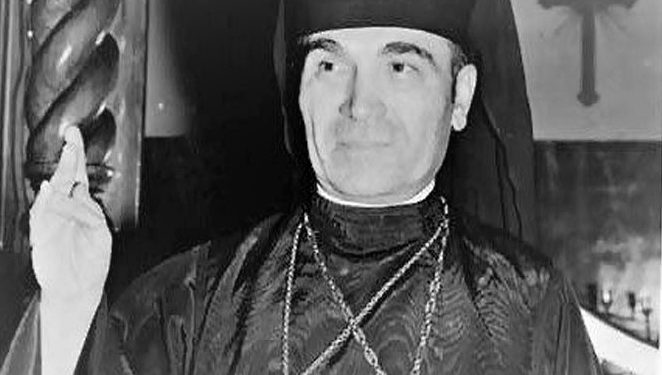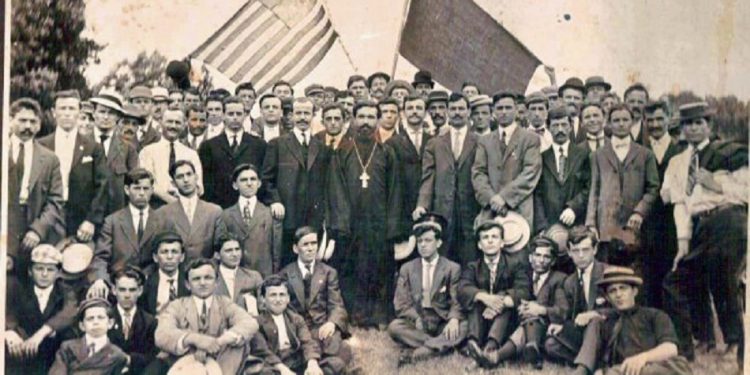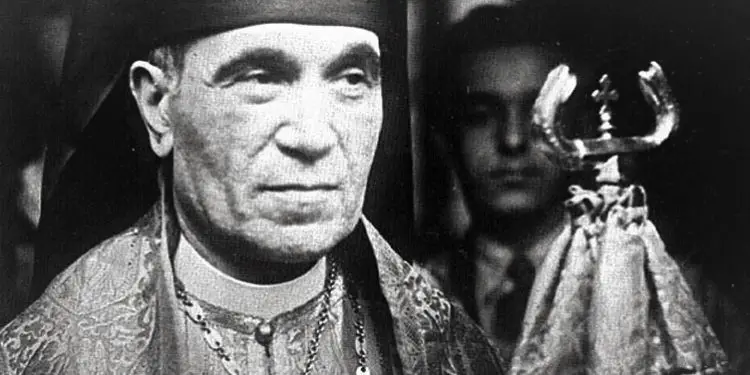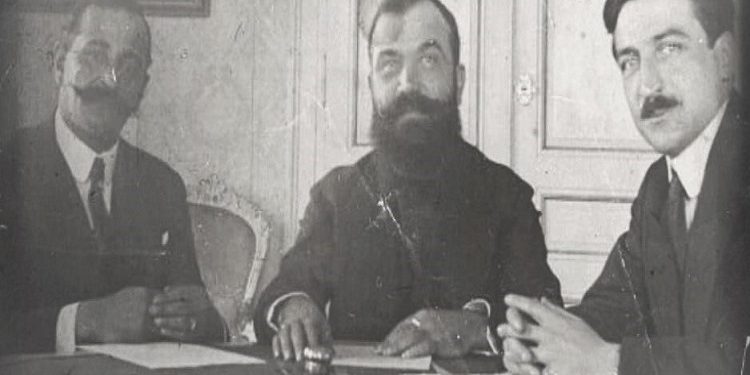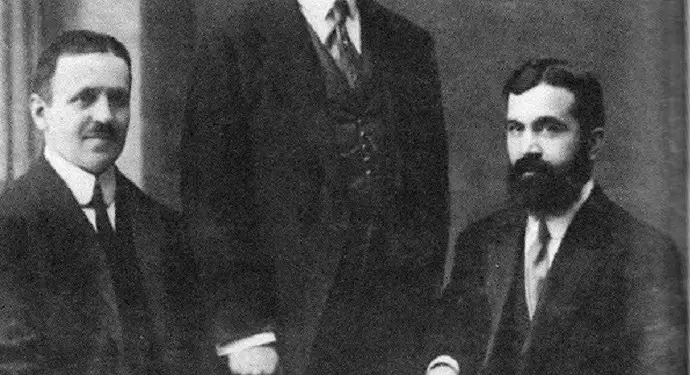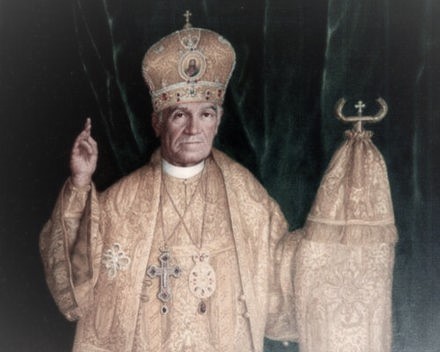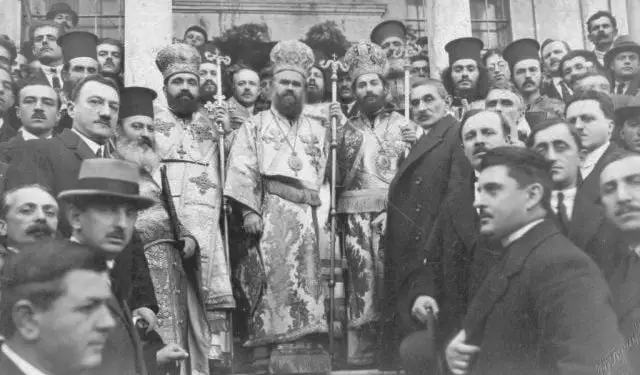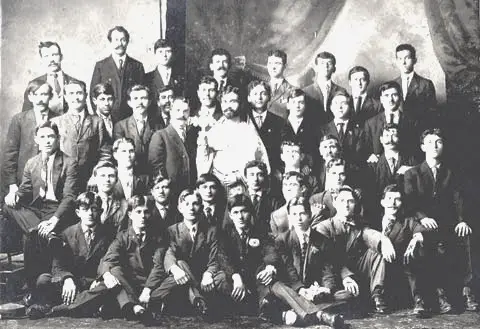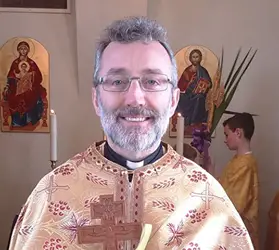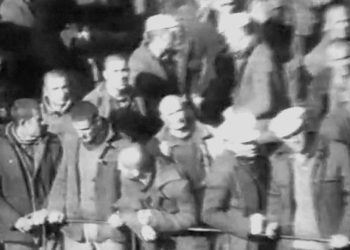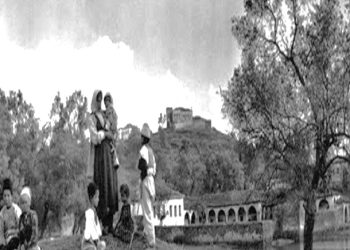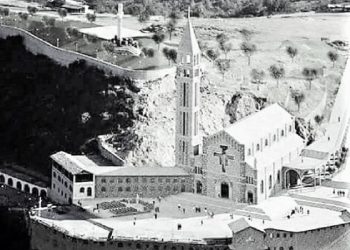From Father Foti Cici
– “Surprisingly, President Truman took part in this intrigue, facilitating Marco Lipa’s entry into America, outside the immigration law”-
Memorie.al / In 1950, the Albanian-American community culminated in a crisis of division, which focused on the person of Fan Noli. The conflict, which was more political and less ecclesiastical, was caused by the Albanians themselves, who had been seeking the replacement of Noli with another bishop for years. They accused their high priest of being a “communist”, also starting from personal grudge, as well as taking advantage of the anti-communist movement that permeated America in those years. In the following, the Albanians sought the help of the Greeks, to eliminate the old prelate. This fratricidal campaign was stimulated by the policies that prevailed in Albania and Greece. In 1948, the communist government demanded the resignation of Archbishop Kristofor Kis, who, as an educated and ordained bishop in Istanbul, was considered a man of the Patriarchate.
In his place, Archbishop Paisi Pashko (Vodica) was enthroned, who was not recognized by the Patriarchate and its admirers. On the other hand, the end of the civil war in Greece, when the communists lost many people along with the possibility of power, took an extreme political form. These developments gave occasion to the two Bishops expelled from Albania, Pandeleimon Kotoko and Evllogji Kurilla, to propagandize against the communists, who had declared the two filogreks enemies, and who were “under the yoke of Vorio Epirin”. The “red” Noli, who had ecclesiastical ties with the new “anti-canonical” synod of Tirana, was also marked. After some Albanian churches broke away from the jurisdiction of Bishop Noli, they sought affiliation with the Greek Church. We must clarify here, that then the Albanian churches were not united, and always under one Bishop, which was achieved only when the Bishopric came out of independence and was accepted under the jurisdiction of the Orthodox Church in America.
In the 40s, there were Albanian churches that sometimes knew and sometimes did not recognize Noli, which made his church position even more fragile. The Patriarchate then sent an Albanian Bishop, Marko Lipen, to America. The conflict of the 50s is still witnessed today, with two churches separated from the Albanian-American community, which today belong to the jurisdiction of the Patriarchate of Istanbul. Therefore, in this article, the circumstances of the ecclesiastical status of Noli have been clarified. The responsibility of the Albanians in the meantime has been silenced by the past, while today, some survivors in the diaspora have decided to make history, perhaps even to justify themselves. Having seen and experienced during the last years the same phenomena, which can cause similar situations today, I tried to outline the situation of those years, crossing the data of the time with people of the Church, outside the Church and against the Church. This is the reason that this article will have more references than the writer wants.
ALBANIAN AND GREEK AGAINST FAN NOLIT!
The impression of our generation is that Albanians have always been innocent in Albanian-Greek conflicts, especially in the diaspora, and therefore in innocence, the future of Albanian-Greek relations should be outlined. When conversations happen between us, it is natural that only our voices are heard. The dead have no mouths, while the living defiled speak no other language than monologue. In the case of the 50s, however, the division between the Albanians of America was what caused the intervention of the Greek circles, and this is also outlined by the documentary evidence. The attacks against Noli were launched and resisted within the Albanian community.
Qerim Panariti (1892-1976), editor of ‘Diellit’ and secretary of ‘Vatra’, as well as one of Noli’s close people, will be quoted here: “The heaviest cross that Noli carried, my shoulders and tired, it was the cross of Dr. John Nasse, a resident of Southbridge […] In 1937, the Albanian community of Southbridge, increased and multiplied and the old church, erected in 1912, was too small to accommodate such a large number of people. Dr. Nasse played a major role in the construction of the new church, on the site of the old church. Unfortunately, all this year, Dr. Nasse talked to Noli and started his activity to find a new bishop for the Albanian Diocese of America, and he started the work by writing to Pandelimon Kotoku, who was coming to America, to preside over the diocese in question. Pandelimon Kotoku replied that he is coming to America if Noli invites him”. (1)
Only from this passage, from an Albanian-Albanian source, it appears that the conflict is much earlier than the year 1950, and the fact that an Albanian-American, with influence in those years, makes open war against his Bishop, shows how dim are our estimates, of the living Noli and his turbulent days. Later, Bishop Kotoko, changed his mind and went to America. Initially in 1947, but with a political and not a church mission. His co-priest, Metropolitan Jerothé Jahopulli, perhaps the most dramatic figure of Albanian Orthodoxy (he was the one who, together with the later Archbishop, Kristofor Kisi, ordained Nolin Peshkop, but was later expelled from Albania), writes to Kotoko from the Holy Mountain ( Athos-Greece): “I learned with joy that you are in America, next to my fellow patriot, Metropolitan Athenagoras, with whom you cooperate on the national issue, for the liberation of our homeland from the heavy yoke […] I wrote a letter to Bishop Theofan (Fan Nolit), through Protopresbyter Dhim. Iliopoulos, who answered me and sent me twenty dollars as a help […] If the Highest and our brother in Christ, the saint of America Athenagoras, will be exalted to the ecumenical throne, then I am more than sure that even The Church in Albania will walk on the right path and this writer will abandon the life of a monk on the Holy Mountain. Access to the ecumenical throne goes through the president of America and the Turkish ambassador there.” (2)
Our topic this time is not the Patriarchate nor the issue of the election of its hierarchs, including the bishops in the service of the Albanians, in the past and today. Nor do we intend to deal with the theology of these actions, the sensudges of the past, especially when we pray to the Holy Spirit, to go before for influence and approval, from the American President and the Turkish ambassador. What is related to our conversation is that even Jerotheu, who was much more religious and stayed politically far from Kotoko and Kurilla, knew the situation well; Archbishop Athenagoras, who was Albanian-speaking, was appointed whenever necessary, and the Ecumenical Patriarch was enthroned in Istanbul. When Athenagoras rose to the throne of Constantinople, he made moves that were interpreted by the Albanian-Americans as an attempt at sedition, such as the sending of Bishop Pandeli Kotoko.
Noli’s biographer, Qerim Panariti, despite not being aware of the church’s mentality and details, continues: “Kotoku’s refusal to come to America does not depress Dr. Nassen, and continue the vendetta against Noli. In 1949, two angry priests informed Dr. Nassen, that there was a young man with extensive education in Istanbul who could take Noli’s place. The one in question, the former Mark Lipa, who became a deacon, priest and deacon, within a short time and in 1950, came to America. Surprisingly, President Harry S. Truman took part in this intrigue, facilitating Lipa’s entry into America, outside the immigration law. Fortunately, the Southbridge patriots, against Dr. Nasse, refused to put their church, the legal mother of Lipa. Unfortunately, Dr. Nasse, I continue the vendetta against Noli, in other ways. For example, I refuse for a long time, to accept Noli to hold Episcopal mass, in St. Colle of Southbridge”. (3)
The war against Noli started within the community, that is, by the Albanians themselves, for political and personal reasons, mainly, and this is how the Bishop himself lists the dangers, when he informed the Albanian government’s representation in New York: “They are fighting me inside the Church, elements ambitious and anti-national, they are also fighting me from abroad, from the Greek Patriarchate of Istanbul, which has also prepared a certain Marko Lipa, to make him Bishop of the Albanians of America, in my country”. (4) This testimony marks the year 1949, a year before the ordination of Marko Lipes, Bishop. So, the division and the war against Noli was such that the Albanians demanded at all costs, his elimination, even by putting in his place, a young man who had just finished his theological studies.
Analyzing the situation of those years and bearing in mind the ecclesiastical policies of the Patriarchate, we ask: If the Patriarchate had serious plans to eliminate Noli, why not ordain Lipa in secret, and likewise, send him to America?! Cold-blooded evidence proves that Marko Lipe was conceived as a result of the intra-Albanian schism, and this schism was so strong that it was discussed openly for years. Otherwise, we do not know if the Patrikana would be activated with the Albanians of America. But Bishop Noli was strong and the only way to lower him was what His Grace never expected from the Albanians: the cooperation of the Albanians with anti-Albanian circles.
While Noli was being threatened by Albanians and Greeks, what were his connections with the Albanian priests, his subordinates? Shouldn’t they have been the consolation of their aging prelate in persecution?
“We are not doing any injustice to Noli, nor to the clergy, if we are presenting the facts, simply regarding the relations of the clergy with Noli, which, in well-weighted words, have been miserable. All the troubles that Noli had, during his administration as the spiritual leader of the Church, I suffered from a part of the disobedient clergy. The Church of St. Trinity, which Mark Lipa enjoys today, was torn away from St. George’s Cathedral by an angry priest. Saint John the Baptist was separated from Saint George by a disobedient priest. Two other priests were the cause of Mark Lipa’s arrival in America […] Noli, it seems, was horrified, because it seemed to him that the nose of the Greek camel was approaching the tent of the Albanian Orthodox Church” […] The conflict of the Greek Church with the Albanian Orthodox Church, it is not religious, it is political. Albanians are very sensitive when they talk about union with the Greeks”. (5)
While it has been imposed on us, through repetition, that it was the Greeks who fought Noli and who brought about the break of our diaspora, while we have always been the victims, the surprise of our generation brings questions that have no answers: Why the Albanians, led the Greek Church, when on the other hand they complained that its goals were harmful to Albania and the Albanians? Characters of our ecclesiastical mess, whom we conventionally call autocephalists, have revealed themselves in the last two years to be hiding in similar circumstances, trying to co-operate under the rug and, outlawed, with camp people they hate, only only to bring pollution, to those who promise to enlighten dark matters.
OFFICIAL ORTHODOXY AND BISHOP THEOPHANI
Being under all-round pressure and, at an advanced age, Noli requested, in the spring of 1949, the help of the mother Church, the Autocephalous Orthodox Church of Albania, through the representatives of Albania, in the USA: “Now, not only am I I am getting too old, a real war has started from the Patriarchate of Istanbul, against me and against our Church here. We must get ahead of this evil. Therefore, I want the Synod of the Autocephalous Church in Albania to agree to recognize the Church here as its branch for all effects”. (6) This was a risky step due to the very fact that the affirmation of the Albanian Bishopric in America, with Albania, would open the Bishop to more difficult problems with the American government, while until then, the issue had been unofficially resolved: Noli was administratively independent, just like other orthodox episcopal units in those years, which kept the Bishopric away from trouble with the American government, while basically, Noli was in communion with KOASH, which the Greek Church itself will testify to, as will mentioned below.
Archbishop Paisi, who was elected in 1948, called the church congress in 1950. “These days in Albania, the Congress of the Autocephalous Church of Albania met and, with a special resolution, decided that the Albanian Church of America, headed by Bishop Noli, to connect with that of Albania. I sent the resolution to the bishop; I believe you will also see it in the Bulletin of our legate and in the press there. I hope that this decision will help strengthen the Church around Peshkopata and unite all Albanians”. (7) Behar Shtylla’s testimony intersects with Article IX of the last KOASH statute, sanctioned in the same period, which foresees the organization of the diaspora in separate bishoprics, dependent on Tirana. In the conditions of Albania at that time, there was no way to predict today’s immigration, but it was about the Albanians of America.
The division of the Albanian community, the campaign of two bishops, Kurilla and Kotoko, in Greece, who prayed that after the war, they would return safely to Korça and Gjirokastër, respectively, and others, were enough to reach such agreements between the government communist, the leadership of KOASH, and Bishop Theofan Nolit. Today’s generation finds it difficult to understand Noli’s connection with the dictatorship regime, but if we deal with this issue in a comparative plan, with other eastern churches, the Albanian Bishop had two solutions: Either to cut ties with Albania, or to abandon the priesthood and the Bishopric. What about the Greek Church? What was her attitude towards Noli? The professor of ecclesiastical history, at the University of Thessaloniki, Apóstolos Glavinas, whom we quoted above, has written a unique work on our ecclesiastical history, the most complete that exists, but from a one-sided point of view. There is no need to ponder why in the fourth edited edition of this church history, the terms on Noli have not changed. Without labeling his partisan position, Glavinas treats the topic of the division of Albanians in America like this:
“On August 31, 1950, the Ecumenical Patriarchate chose Archbishop Marko Lipe as assistant Bishop of the Archbishop of America, with the title of Bishop of Lefka. Marko was Albanian and it is understood that he would serve the Albanians of America, who were opponents of the communist regime in Albania. But this appointment caused the anger of the Albanian Bishop, Theofan (Fan) Noli, who lived in America and was the leader of the Orthodox Albanians there. Theofan Noli, immediately rushed to inform the Holy Synod of the Autocephalous Orthodox Church of Albania and its primate, Archbishop Pais, with whom he was in communion”. (8) Only from this laconic assessment of the professor, which in other cases, is too detailed in Albanian issues, even when it is not necessary, many truths arise; here are some of them:
The Great Church of Christ, the Ecumenical Patriarchate of Constantinople, according to Glavina, divides the members of the Orthodox Church into communists and anti-communists, exploiting the disunity of the Albanians. Official Greek sources hide the truth from contemporaries, that Marko Lipe was a layman/civilian and was ordained a deacon, priest and bishop like lightning, exceeding the canon laws. If this violation had to be accepted, with the practice of ecclesiastical economy, then why doesn’t the Synod of KOASH ordain today two clergymen or, laymen, from those who possess in Albania, even with disabilities, to fill the two shortages in Bishop, what is the Orthodox Church in Albania?! What reason is expected, for a reuse of the church economy, among the Albanians, when it was used before, to divide them?
Such an attitude today, especially after a sudden change, carries the premises to take KOASH, again to the 30s. Bishop Theofani was in communion with Archbishop Pais, whom the Patriarchate did not recognize as canonical. So, Noli was just as “anti-canonical”, as all the other Albanian bishops of those years, except the hierarchs, ordained by the Patriarchate. Was this a legitimate fact, for the Orthodox Church to get rid of Noli, after the departure of Archbishop Kristofor? But wasn’t Kristofori the one who co-ordained Bishop Nolin in 1923 with Metropolitan Jerotheu, both of whom came from the Patriarchate?! Let’s follow the sequence of events, through testimonies.
Archbishop Paisi, convinced by the data of Metropolitan Theophanes, and encouraged by the government as well as the events that followed the arrival of Bishop Markos in Boston, protested to all the primates of the Orthodox churches, starting with the Patriarch of Russia: “These actions of Ecumenical Patriarchate, are intended to break the ecclesiastical and national unity of the Orthodox Albanians in America, serving at the same time the hostile interests of Greek chauvinism, which are opposed to the ecclesiastical and national rights and the interests of the Albanian Autocephalous Orthodox Church and the people Albanian […] On behalf of the Synod of the Autocephalous Orthodox Church of Albania, its clergy and people, I protest with indignation and ask the Ecumenical Patriarchate to put an end to such actions, which desecrate the principles of the Eastern Orthodox Church and friendship and fraternity between peoples.
I also ask the Ecumenical Patriarchate to review and cancel the illegal decision on the appointment of Marko Lipes as Bishop of the Albanian Orthodox Church in America. At the same time, I fervently pray to all the gracious patriarchs of the Orthodox Church to intercede, requested by the Ecumenical Patriarchate, to stop the hostile actions and return to the path of the true Orthodox religion (9). Patriarch Alexey of Moscow responds to his brother the primate and this colors a new situation between the churches. While the patriarchate of Istanbul did not know the new Archbishop of Albania, the Russian Church was given the opportunity of honorary maternity: “Blessed! The Russian Orthodox Church joins its voice with the complaint of Your Grace, against the interference of the patriarchal throne of Constantinople in the canonical rights of the Autocephalous Orthodox Church of Albania. […] Such a violation, by the throne of Constantinople, of the rights of the Albanian Church, undermines the spiritual unity of Orthodoxy. […] The Russian Church raises its voice to defend the canonical rights of the Albanian Orthodox Church, moreover, the Russian Church itself has become a prey to the anti-canonical actions of the throne of Constantinople, during the last ten years”. (10)
THE PRELATE’S OBJECTION
Although Bishop Marko Lipe settled in the USA, he could not establish the plans of the Albanians to replace Theofan Noli. The separation of the two Albanian Churches and their introduction under the jurisdiction of the Greek Church, although it proves a break in the Albanian community, was treated as “salvation” and even the old Bishop, half-amused, confesses to Behar Shtylla: “Even the Albanian Church, and myself, they did not spare us. The case of Marko Lipe became the case of Marko Lipe against the Church and against me. This wretch became a blind tool of the Greek Patrick, it seems that his mind grew, like the frog in the fairy tale, but even here, unfortunately, there were some disgruntled Albanians who supported him. […] This whole maneuver, to bring Marko Lipen to the head of the Albanian Church of America, failed and was crushed. The Church was saved, the colony and the future of Albanianism, in America, were saved”! (11)
This does not mean that the warring campaign against Noli came to an end. Terms were exchanged. After the elimination of the Metropolitan failed, Bishop Marko asked to be accepted and entered into the Bishopric of Noli: “In 1963, an Albanian association, “Albanian Veterans, was pushed by Mark Lipes’ clique to hold two meetings, to brought Lipa to the Albanian Autocephalous Church. The veterans gave up when they understood the intrigue of the Greeks”. (12) Here, the same witness, Qerim Panariti, writes that the Greek Church requested his cooperation, through a Greek lawyer, to intervene with Noli, on the admission of Marko Lipes to the Bishopric. So, the problem was already dealt with what would happen to the Albanian community, according to Noli. But one question has remained unanswered, from the side of the Greek church: How would Bishop Marko concelebrate with Bishop Theofan, when the latter was “anti-canonical”?! Such an act, together with non-canonical clergy, is a double standard for the practice of the Orthodox Church!
On the one hand, they wanted to unite Noli with Lipe, while on the other hand, they did not accept him to the Synod of Canonical Orthodox Bishops of America, which was created in 1960. They did not accept him precisely because the presence of Marko Lipe in the Greek Church, who presided over this forum, came into conflict with the existence of Noli in the USA, despite the fact that in reality it should have been the opposite: Bishop Theofani, ordained in America. Not being involved in SCOBA, as the Synod of Canonical Bishops is called, was perhaps Noli’s biggest concern. He worked and dreamed so much for American Orthodoxy, but in the end, he was left out of the bridal party. We don’t know exactly what Noli felt in essence and where the emotion began and ended. In a letter addressed to the Russian prelate of America, he once showed his vision for the structure of an American Orthodox Church, Autocephalous, which Church or Patriarch, should exclude the Greek Church from the headship. Even when this began to be structured, through the SCOBA forum, whose chairman was appointed the Greek Archbishop, Noli, starting from this fact alone, continued to talk about the union of the American Orthodox. Nolian predictions that; SCOBA is the “Greek” plan of Americanization, it was based on nothing but emotional feelings.
Except that no other ethnic Church in the USA – all of them more powerful than the Albanian one – had reasons similar to Noli’s, in opposing the Greek-American Church. The non-recognition of the Bishop, on the other hand, moved to a legalistic level, rather than a legal one, especially when it comes to the terms of the Greek Bishopric. Behar Shtylla writes in his diary that; in 1956, he heard the ‘Voice of America’, a news item, where Noli was massing together with clergy from several Orthodox church jurisdictions: “In the city of Bridgport, a religious ceremony was held, attended by over 600 people, Albanians, Romanians, Russians, Syrians, etc. Bishop Noli […] led the mass assisted by Russian, Carpatho-Russian, Romanian, Albanian, Syrian priests. (13) Well, what orthodox bishop allows his priests to commune with an illegal bishop?! Although in the days of Noli in America, there were quite a few independent hierarchs, bishops were known who possessed in their high priesthood intact the succession procedures, even more so for a Bishop like Theophanes, who had received the grace of high priesthood from the hierarchs themselves of the Patriarchate, in 1923.
Having brought here the evidence of that time, illuminating aspects of Fan Nol’s ecclesiastical life, it now remains for us to look at the question of his ecclesiastical independence. This is one of the accusations that is often used against him: Marko Lipe was from the Patriarchate, while Noli was independent and therefore “illegal”. Noli could have been isolated as a bishop, for reasons more than justified at the time, but when he started the priesthood, many Greek priests behaved those ten years in America as independent, while only the Russians had an episcopal presence in North America, while The Greek Church, only in the 20s, was organized into the Canonical Church, with a bishop appointed by the Patriarchate (still today there are remnants of that church period in the USA and Canada, with independent bishops and priests). Following Behar Shtylla’s notes, on the issue of Noli’s affiliation with Tirana, it is explained that KOASH decided to put the Bishopric of America under its jurisdiction in 1950, as we described above, but in reality, this didn’t happen?! Because the resolution was approved, at the request of Bishop Theofani himself, and was forwarded to him by the Albanian government representative. Why not then?!
“Several times the assembly of the Albanian Orthodox Church in America has discussed the issue of union with the Autocephalous Church of Albania. He concluded that; political circumstances beyond his control make this union impossible. He even thinks that even if the international situation changes, it would not be advisable for the Bishopric of America to be placed under the jurisdiction of a Mother Church, outside the United States of America. According to the Orthodox tradition of the East, every independent state should have an independent Orthodox Church, therefore an American Orthodox Patriarchate should be formed, which would summarize all the Orthodox groups of this country. Whenever such a structure is organized, the Albanian Orthodox Church in America would be happy to become a part of it, along with other Orthodox groups.” (14)
With these measured and clear words, Noli tells us everything about the motivation of his ecclesiastical “independence”. Marko Lipe, could not conquer Peshkopata, except to break a small part of it. Consequently, Noli’s reluctance to affiliate with Tirana in the late 1940s increased after Lipe’s arrival and failure in America in the early 1950s. Moreover, and this is the strongest reason, this event coincided with the rise of the anti-communist movement in the USA, from which the Bishop was in danger, as he was later attacked in the press, and even questioned by the American authorities. But ecclesiastically, in a fundamentally orthodox perspective, he was and remained in communion with KOASH, the Autocephalous Church that he co-founded in 1923, regardless of the form of administrative independence. Before closing his eyes, in 1965, he sent to Tirana Father Stefan Lasko, who was ordained Bishop and returned to Boston, at the feet of his successor and spiritual father, Theofan.
And this orthodox fact, is the main sign that protects the episcopal status of Theofan Noli, who is unfortunately slandered today by experienced clergy and novice churchgoers. When “Vatra” was launching a campaign to buy a house for Peshkopi, a job escape for the inexhaustible old man in creativity, many patriotic Albanians fought it. “Many of those who are shedding crocodile tears today for Noli, for example, the leaders of the “Free Albania” Organization, not only refused to help, they were promoting the campaign in every way. The Albanian words: ‘I die without I love you’, are applied one by one in this case”. (15) The campaign against Noli, which started at personal and political levels within the Albanian community in the USA, and which developed in a combative manner, intersecting human passions, especially revenge, and political interests, Albanian and foreign, took guides an ecclesiastical form, which, if seen impartially, raises up a great figure, Fan Nolin, and greatly lowers the sellers of the missing virtue: understanding and acceptance of intra-Albanian differences.
Noli is so masterful that he doesn’t need the banal exclamations of the uninvited. His life and works require the post-dictatorship generation to learn valuable lessons to solve similar situations, on the one hand, and to insist on renewing Albanian thought, on the other hand. Noli is didactic, so as not to get used to the disunity caused by outmoded mindsets. Fan Noli, the Elder of America, did not use slander and denigration to defeat those who did not agree with his positions, as is happening today in the Albanian-American community. Individuals, who spent their whole lives in an enigma, who had forgotten that they were Albanians, who did not even go to Noli’s funeral, who are not well known, what they did all their lives, especially when Noli lived, came out these years of old age and of hope, to make us the canon of Albanianness. Fan Noli, in the same way that he had sacrificed the “freedom of freedom”, had also exalted the productive debate, denied today by the characters who try to influence the issues of Albanian orthodoxy. /Memorie.al
- Qerim Panariti, “Noli: Uncrowned Prince of the Albanian Renaissance”, Fan S. Noli, Album II, p. 106-107.
- Letter of Metropolitan Jerothé of Militupojë, 15 August 1947, quoted by Apóstolos Glavinas, Autocephalous Orthodox Church of Albania (Απόστολος Γλαβίνας: Η Ορθόδοξη Αυτοκέφαλη Εκκλησία της Αλβανίας), 1998, p. 122-123.
- Qerim Panariti, Album II, p. 107.
- Behar Shtylla, Fan Noli as I have known him, 1997, p. 96.
- Qerim Panariti, Album II, p. 101-102.
- Behar Shtylla, Fan Noli as I have known him, p. 94.
- , p. 94-95.
- Apóstolos Glavinas, Autocephalous Orthodox Church of Albania, p. 128-129.
- , p. 129-130.
- , p. 130-131. The Greek Patriarchate of Istanbul is mentioned three times in this short fragment, but not as Ecumenical, precisely because the Patriarchate of Moscow calls the church in question simply as the Patriarchate of Constantinople, thus denying the Phanar’s tendency to hegemonize, always through the Ecumenical trap suffix.
- Behar Shtylla, Fan Noli as I have known him, p. 98.
- Qerim Panariti, Album II, p. 103.
- Behar Shtylla, Fan Noli as I have known him, p. 101.
- Metropolitan Fan S. Noli, Fiftieth Anniversary Book of the Albanian Orthodox Church in America, p. 22.
- Qerim Panariti, Album II, p. 105.




